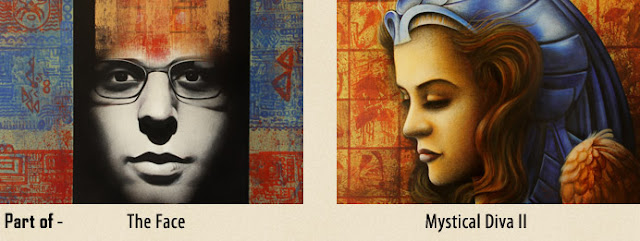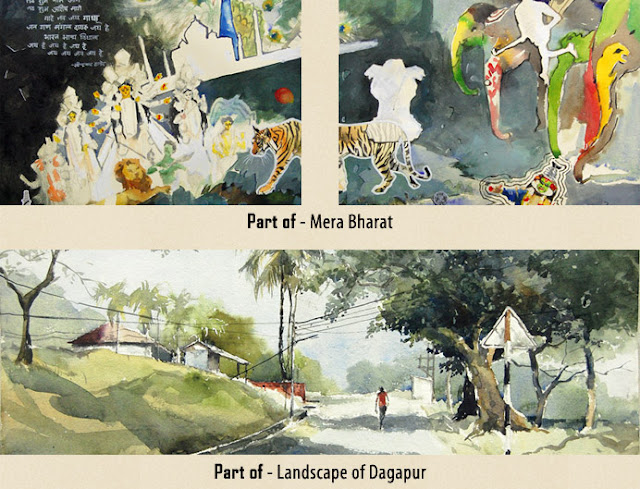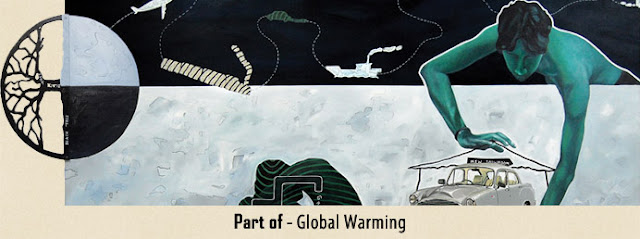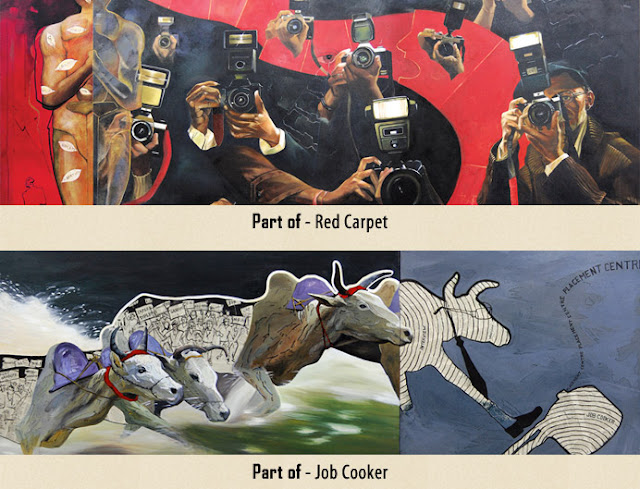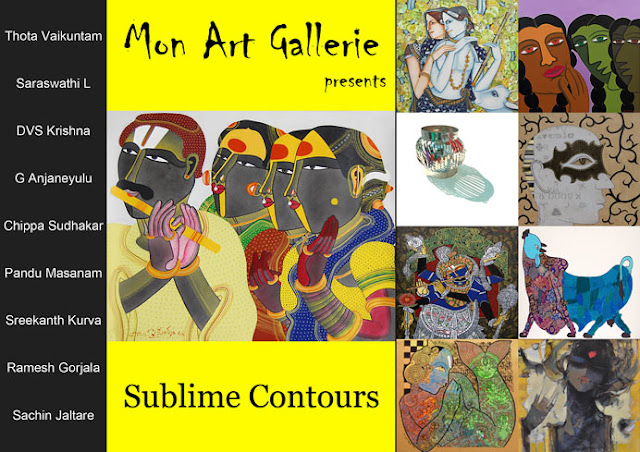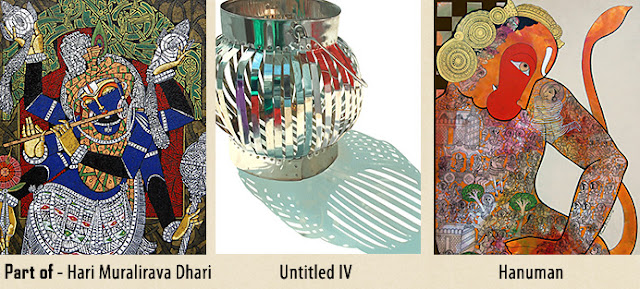Mythical Paradigms
VIEW ALL THE ARTWORKS OF THE SHOW
Download the catalogue HERE (3.7mb size).
Dream and Destination
VIEW ALL THE ARTWORKS OF THE SHOW
Download the catalogue HERE (3.7mb size).
Lyrical Journeys
Jagannath Paul’s art articulates the belief that certain creative principles exist eternally. These principles are preserved in the collective consciousness embodied in myths which somehow capture the essence of these underlying thoughts and ideas. Idiosyncrasies of time and place prove to be ephemeral: they arise, flourish for a while and then disappear. The dramas reenacted in Paul’s works do not.
Instead they recreate the eternal paradigms in constantly changing variations and degrees. Art, for Paul, involves a rediscovery and a revelation of the eternal paradigms, which exist in that dimension of infinitely expanded space and time. The very existence of this eternal transcendent realm is revealed only by the artist. Only he has the vision, and only he has the courage to express that vision, regardless of what it may be or what it may allude to.
The artist, then, creates, or rather recreates, a bit of eternity in permanent form. The mythic or transcendent faces – beautiful and filled with rapture – that exist in Paul’s notion of eternity contain a kernel of truth which, though not widely recognized, is nevertheless manifested in the cycles of every human life.
Artists express their essence in the way they create: the more in tune they are with themselves, the closer they will come to expressing that essence coherently and clearly. Paul’s works appear not only to express his subjective essence but also recreate or, more accurately, re-actualize one of the mythical patterns that have served as models for human existence since time immemorial.
VIEW ALL THE ARTWORKS OF THE SHOW
Download the catalogue HERE (3.7mb size).
--------------------------------------------------------------------------------------------------------------------------------------------------------------------------------
Dream and Destination
Bipul Roy applies water colour in light transparent washes. The softness and translucence of the medium induces a kind of dreamy environment transforming the naturalistic ambience towards an impressionistic meditative lyricism. This is true particularly about his landscape paintings. He loves to paint landscapes since his early college days. Through imaginative application of chromatic wash and creating areas of highlight leaving white space of the paper he creates a kind of duality of the space and the void. This duality reflects the essence of his personality, his dream, his love for nature. His landscapes are mostly silent and contemplative, particularly the hilly landscapes of North Bengal. Apart from the landscapes of Dooars, Darjeeling and North Bengal in general in this show we also find his water colour landscapes of the city of Kolkata. Through working with these landscapes and cityscapes he tries to enter into the deeper reality of the country, its inner beauty and contradiction. His dreams for beauty and ideal states of being play an important role in this genre of painting.
With these dreams he proceeds towards ‘destination’. But experiencing the complexity of reality all around, he is not confident about the nature of his destination. He is sure about the journey he has to undertake but not about the goal. So he ruminates, contemplates how to confront the reality. Out of that contemplation about the state of affair of the world and his own country, he develops the concepts and forms of his paintings. He constantly questions, tries to come out of the confusions but cannot always escape the shadow that looms large between his journey and destination, between his endeavor and achievement.
That shadow of confusion dictates his form. He plays with that shadow to come out of it in order to identify his destination and also the destination of the world around him. His conceptual works are the results of such groping with shadows, ruminations, confusions and dreams through which he constructs his destination. In his conceptual works he is rebellious. He questions and experiments with forms and finally creates a thought provoking composition through which he dissects, analyses and enters deeper into contemporary reality. In his conceptual works he uses acrylic on canvas, often merges it with installation like construction.
VIEW ALL THE ARTWORKS OF THE SHOW
Download the catalogue HERE (3.7mb size).
--------------------------------------------------------------------------------------------------------------------------------------------------------------------------------
Lyrical Journeys
Watercolours are among the hardest of artistic techniques to master, for unlike oil or even acrylic painting, where the paint stays where the artist put it, water-soluble paints are runny and difficult to control. Mistakes cannot easily be painted over. The artists in this show, however, all have considerable mastery over the medium and it is always particularly interesting to see what it is about the principles by which their art is controlled and the methods they employ in their practice. It is, of course, in their work, in the things they create, that they give the complete expression of their convictions and that the full product of their experience is embodied, but they are also able to declare the intentions by which their expressions have been directed and also to explain the technical processes which have enabled them to arrive at their results.

Arup Lodh’s works are atmospheric and combine a unique accuracy of observation with incredible technical precision. He has a deep and intuitive understanding of the special advantages of this fluid and sensitive medium for capturing the feel of a particular place or moment and appreciates the inner vibrancy of the city of Calcutta

A sense of divinity is implicit Sandip Roy’s watercolours or Varanasi and Allahabad
Sudip Roy is acutely aware of the fact that watercolours come with a set of rules. It is not at a conceptual level that those rules are played out. It is in the act, in the materiality, the seductiveness of the surface, the submission and the hours that are put in to create a sense of sublime translucence. To this end, his watercolours are very meditative and meaningful gestures, much like rituals and more about subverting modernity that subverting tradition in the sense that they are spontaneous and gestural.
--------------------------------------------------------------------------------------------------------------------------------------------------------------------------------
Sublime Contours
Starting from 8th April to 7th May 2011
The uniqueness of a region would not have continued to generate wonder among its visitors had there been a thorough-going blurring of all cultures. Flatness of cultures is sure to cause death of wonders and eventually dry up all dreams of a civilization.
Indian art down the Vindhyas has still been able to retain its ethnic particularities to a large extent till date. What characterises the works of the artists hailing from Andhra Pradesh is a strong cohesiveness almost like a shared experience.
The ornate style; the subject matter; the timelessness; the neutrality; the contemplative mood; the spirituality; harmonized images with a rhythmic movement about them, heightened by the continuously flowing lines exuding vivacity emphasize the emotive, the historic and the habitual.
The characters, flora, fauna and symbols in the paintings in this exhibition are in fact ingrained in social consciousness of most Indians.
Marked by a penchant for retreating into the idealized and nostalgic, perhaps every art form of this South Indian state is a derivative of the Indian classical sculptures and temple architecture, smeared with the richness of the country’s traditional imagery. The images in this exhibition maintain a reticence and yet are unremittingly loquacious.
----Oindrilla Maity Surai
View the show at - www.monartgallerie.com
Download the catalogue HERE (0.93mb size).




